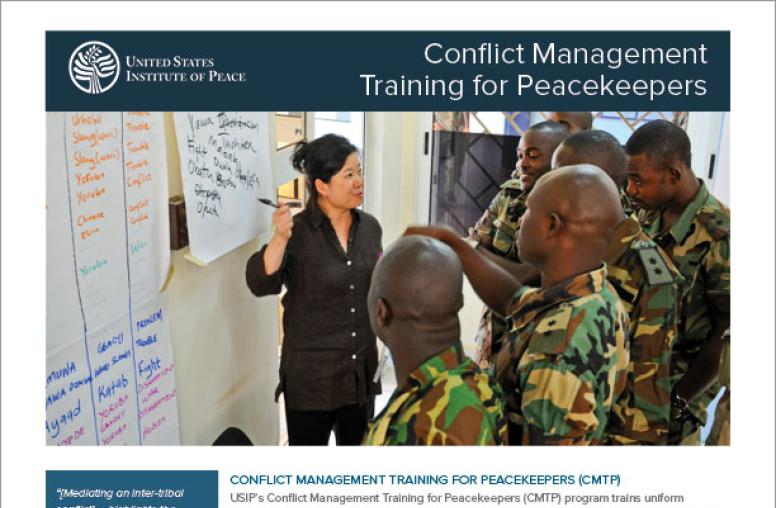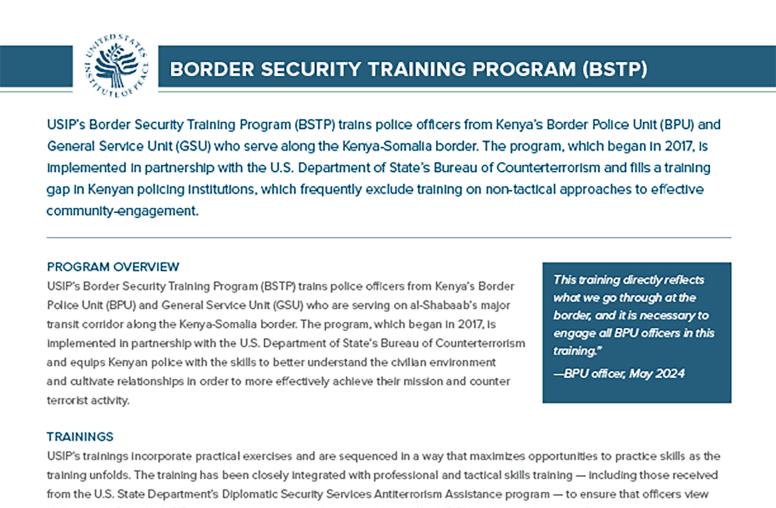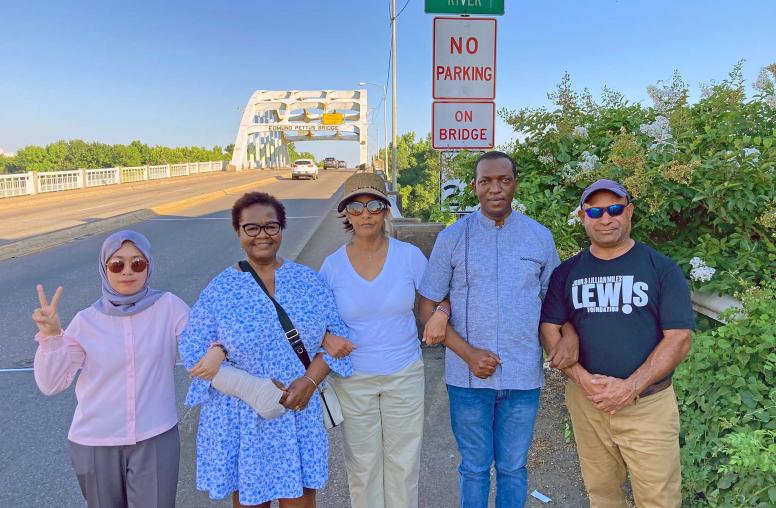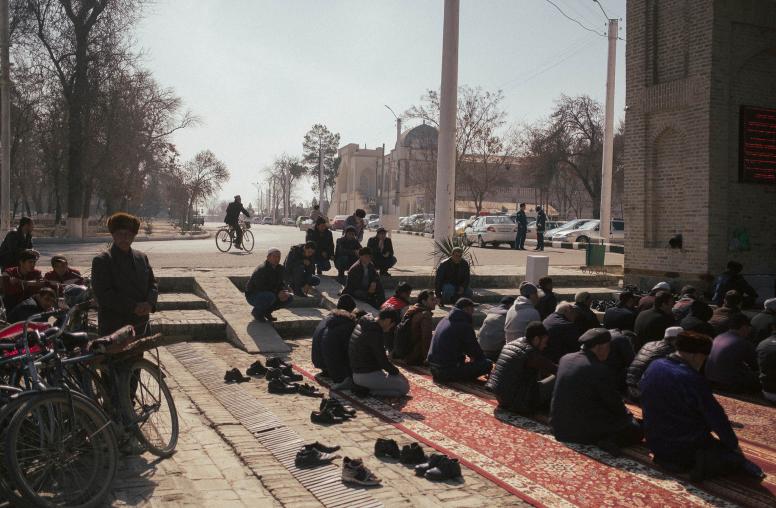Rethinking Conflict: Its Role in Building Peace
When you hear the word “conflict,” what immediately comes to mind?
This is an exercise we often use with students at middle school and high school levels. Off the tops of their heads, their answers typically include “violence,” “war,” “fight,” and sometimes “destruction” or even “hatred.” Looking at these associations, it is clear what the words have in common: they are negative. The dominant connotation in many young people’s minds is that conflict is inherently bad.
So we ask them next: When can conflict be positive?
Gradually, students begin to wrap their heads around this notion and offer responses. They can find examples from world history when struggles for civil rights and political rights led to positive change. They may cite examples from their own lives, when a disagreement with a friend led to a resolution that actually strengthened the relationship.
Our organization, the United States Institute of Peace (USIP), defines conflict as “an inevitable aspect of human interaction…when two or more individuals or groups pursue mutually incompatible goals.” Importantly, the definition clarifies: “conflicts can be waged violently, as in a war, or nonviolently, as in an election or an adversarial legal process. When channeled constructively into processes of resolution, conflict can be beneficial.”
Simply put, conflict in and of itself is neutral. It is a fact of life. People disagree, argue, even fight. It has been this way throughout human history. It is this way in our daily lives. We all know conflict, with our friends, our families, our co-workers. It is part of human nature.
But where it leads is not predefined. Conflict is neither intrinsically negative nor positive. In fact, how it plays out is determined entirely by how it is handled—by the attitudes and skills of those involved. Negative assumptions may cause us to try to avoid conflict, or they may lead us to become instantly combative, unwilling or unable to see any possibility of a constructive outcome. This is precisely why it matters that we rethink conflict in how we teach history and in how we prepare students for dealing with the world around them.
Conflict is not only inevitable, it is essential. Throughout history and still today, conflict is the expression of big fault lines and the seed of big changes in our world. If we understand that conflict can be managed without violence, and can in fact be transformed into an engine of positive change, we begin to see how conflict can actually be a critical part of building peace.
By holding up examples that show this throughout history, and by giving students the tools and the perspectives they need to understand and approach conflict in constructive ways, we can open their eyes and their minds to the many men, women, and young people making a difference, and we can open the possibilities for them to find their own roles as peacebuilders.
The Movements
Some of history’s most prominent examples of a different approach to conflict come from mass movements that organized across political, religious, ethnic, or age groups to effect positive change in their communities and countries. Many of these groups faced oppression, discrimination, and threats of (or actual) violence, but they remained committed to confronting conflict nonviolently and using peacebuilding tools to achieve their goals. Consider the following examples.
Protesting and Parading for the Right to Vote
One of the most successful social movements in United States history, women’s suffrage is an example of how nonviolent resistance and peaceful activism in the face of discrimination can lead to effective social change.
Having initially gathered steam during the 1850s, the movement lost momentum during the Civil War. By building on the eradication of slavery and the inception of the 14th and 15th Amendments shortly after the war, women—who were some of the critical activists in the fight against slavery—seized the moment to include women’s rights in the debate on equality. Activists began to unify in the late 1800s through the formation of the National American Woman Suffrage Association, which defended the exercise of free speech, the right to dissent, and free assembly through using innovative nonviolent means to publicize their cause. Influenced by British suffrage processions and the United States’ tradition of parades, suffragists began demonstrating in the streets.1 Successful lobbying efforts and putting political pressure on politicians from state to national levels eventually led to the ratification of the 19th Amendment in 1920, granting women the right to vote
Solidarity in Poland
What started as a single strike at a shipyard in Gdansk, Poland, in 1980 quickly spread to other factories and, just over two weeks later, forced the Communist government to grant permission for what soon became the Self-Governing Trade Union Solidarity.2 It grew into a “genuinely popular movement” that pursued peaceful, nonviolent action to advance the cause of workers’ rights.3 As the union evolved into a movement, the government became concerned and declared martial law. Yet, even though it was outlawed, Solidarity continued to operate through an independent, underground press in a language and manner that spoke to all Polish citizens. The media provided updates on imprisoned leaders, shared the messages of the movement and calls for next steps, and essentially gave the movement a collective identity. Support from the international community helped Solidarity influence the country’s political discourse and made the press an important driving force of the revolution. This method has influenced modern social movements, where all forms of media are used as means to inform, to unify, and to mobilize in peaceful revolution.4
Reconciling After Conflict
Between 1948 and 1990, the white minority in South Africa used legal measures to establish racial segregation policies, which came to be known as apartheid. When a nonviolent resistance began to form, consisting of political action, mass demonstrations, and strikes, the South African government reacted violently.5 The international community began to respond with economic sanctions, ultimately pressuring the government to begin to repeal some apartheid laws and participate in a series of negotiations with opposing parties. A new constitution in 1994 resulted in the election of a government with a nonwhite majority, bringing apartheid to an end through a peaceful transition of power. The peacebuilding process following the end of apartheid centered on the Truth and Reconciliation Commission (TRC) led by Desmond Tutu and supported by Nelson Mandela, both leaders of the apartheid resistance. The TRC was a way to address human rights violations perpetrated during apartheid, providing a path toward healing for the victims.6
The People
Though conflict has often been addressed by groups, it is most frequently at the individual level where choices are initially made about how to approach conflict. What motivates someone to choose nonviolent means? For those who have experienced violent conflict, how has that affected their views and their subsequent choices? What difference has this made in history?
Leaders in War, Advocates for Peace
Presidents George Washington and Abraham Lincoln both served in turbulent periods and led the country through violent conflicts on U.S. soil, but they remained committed to the principle and the pursuit of peace. In fact, George Washington frequently mentioned his preference for peace in his personal correspondence, and commissioned a weathervane in the shape of a dove, a symbol of peace, for his home in Mount Vernon.7 It still stands to this day. Abraham Lincoln ended his Second Inaugural Address with a plea for conflict resolution and reconciliation, saying: “…let us strive on to finish the work we are in, to bind up the nation’s wounds…to do all which may achieve and cherish a just and lasting peace among ourselves and with all nations.”8
Soldier, Lawmaker, Peacebuilder
Spark M. Matsunaga was a second lieutenant in the U.S. Army during World War II when he was detained in a Japanese internment camp. After petitioning President Roosevelt for release, he and other Japanese Americans formed the decorated 100th Infantry Battalion.9 Matsunaga, who later represented Hawaii in both the U.S. House of Representatives and the Senate, had believed from his youth that peacemaking is as much an art as making war, and that it can be learned. He was named chair of the Commission on Proposals for the National Academy of Peace and Conflict Resolution. The U.S. Institute of Peace Act of 1984 was based upon that commission’s findings and recommendations.10
Leaders in Civil Disobedience
Mahatma Gandhi and Martin Luther King, Jr. are remembered as iconic figures because of their commitment and contribution to nonviolent civil disobedience. Although they lived around the world from each other, both led movements that relied on nonviolent tactics to achieve their goals. Mahatma Gandhi was the primary leader of India’s independence movement against British rule that began in 1919 with his call for peaceful strikes, demonstrations, and boycotting British-run sectors in India.11 Beginning in the mid-1950s in the United States, Martin Luther King, Jr. led the Civil Rights Movement, which worked for equal rights and the end of segregation among blacks and whites through peaceful demonstrations that were heavily influenced by Gandhi’s teachings and approach.12
Mediating Violent Conflict in Northern Ireland
In the mid-1900s, former U.S. Senator George Mitchell was invited by the British and Irish governments to lead peace talks to end the bloody conflict in Northern Ireland that had lasted for decades, based on complex religious and political factors. For two years he served as a mediator, devising the Mitchell Principles to set the requirement that the paramilitary organizations use only democratic and nonviolent methods to achieve political goals. Those efforts ultimately resulted in the Good Friday Agreement, regarded as the cornerstone of a commitment to peace and stability in Northern Ireland.13 As part of the U.S. Senate Leaders Lecture Series, Mitchell argued that “no matter how ancient the conflict, no matter how much harm has been done, peace can prevail.”14
Tools for Teachers
The preceding examples illustrate the diversity of conflicts in history, and the range of tools that movements and individuals have used to address these conflicts through nonviolent means. This toolkit for peacebuilding includes skills in communication, collaboration, critical thinking, and creative problemsolving. These tools are, in fact, applicable at multiple levels and in many different contexts—from handling conflict inside the classroom to negotiating agreements in international settings. Explaining this toolkit and making it accessible to students can empower them to see and pursue the potential for conflict to be handled constructively.
There are also tools and frameworks that can help those of us who teach this aspect of history rethink conflict and how we unpack it with our students.
Conflict analysis is an essential skill in conflict management. It enables us to break down conflicts in ways that help us understand the players, the issues, the dynamics, and the broader context. All these pieces of information help explain what is happening, offer new perspectives and understandings, and can lead to new ideas and opportunities for problem-solving. In teaching history, conflict analysis helps us all look more deeply at how conflicts evolved, how they were handled, and why. More broadly, it enables us to learn from that history, to see opportunities that might have been missed, to look for pieces of the story that might really matter even though they don’t usually get the attention they deserve, and ultimately to use this new perspective to better understand conflict in today’s world.
The Curve of Conflict is another useful tool that helps us visualize the evolution of conflict—how it tends to escalate and recede over time—and to see opportunities to prevent it from becoming violent. By deconstructing the dynamic of conflict, we can seek to understand it and handle it more effectively. This is especially true because, along the curve, we can identify discrete stages where action can be taken to prevent, manage, or resolve conflict. In teaching history, the Curve of Conflict enables us to take the elements of conflict identified using conflict analysis, to see how a particular situation moved through stages, and to discover what was (or was not) done to address it as it unfolded. Again, helping students realize that the evolution of conflict may be understood, and can be addressed to avoid violence, is an important lesson in seeing new perspectives and new possibilities for problem-solving.
The Bottom Line
Sometimes it is the simplest ideas that are the most radical. The fact that conflict does not have to be violent—and that conflict can even be a force for positive change—is eye-opening for many young people. It offers a different perspective, not only on history, but also on life. Understanding that conflicts can be managed in ways that don’t involve violence, and there are skills and attitudes that make this possible, is a fundamentally empowering proposition.
For educators, this is one of the areas in which history can most effectively be brought to life. By taking a new lens to what is by definition old content, it is possible to find and teach new perspectives on history, to broaden students’ views and understandings, and ultimately to set them up to be better informed, critical thinkers, and real agents of positive change in today’s world.
Notes
- ”The Fight for Women’s Suffrage,” HISTORY®, last modified 2017, accessed January 26, 2017, http://www.history.com/topics/womenshistory/the-fight-for-womens-suffrage.
- Jeffrey Donovan, “Poland: Solidarity—The Trade Union that Changed the World,” Radio Free Europe, August 24, 2005, accessed January 26, 2017, http://www.rferl.org/a/1060898.html.
- Mark Kramer, “The Rise and Fall of Solidarity,” New York Times, December 12, 2011, http://www.nytimes.com/2011/12/13/opinion/the-rise-and-fall-of-solidarity.html.
- Arch Puddington, “How Solidarity Spoke to a Nation: Lessons for Today’s Democratic Insurgents,” Freedom House, July 17, 2012, accessed January 26, 2017.
- “Apartheid,” HISTORY®, last modified 2017, accessed January 26, 2017, http://www.history.com/topics/apartheid.
- “Truth Commission: South Africa,” U.S. Institute of Peace, 1995–2000, accessed January 26, 2017, http://www.usip.org/publications/truth-commission-south-africa.
- “Letter from George Washington to Jonathan Boucher, August 15, 1798,” Founders Online, National Archives and Records Administration, accessed January 26, 2017, http://founders.archives.gov/documents/Washington/06-02-02-0422.
- Abraham Lincoln, “Second Inaugural Address” American Presidency Project, University of California at Santa Barbara, March 4, 1865, accessed January 26, 2017, http://www.presidency.ucsb.edu/ws/index.php?pid=25819.
- Peter B. Flint, “Spark M. Matsunaga Dies at 73; Senator Led Fight for Reparations,” New York Times, April 16, 1990, https://www.nytimes.com/1990/04/16/obituaries/spark-m-matsunaga-dies-at-73-senator-led-fight-for-reparations.html.
- “Important Figures in Our History,” U.S. Institute of Peace, http://www.usip.org/about/origins-usip.
- “Mahatma Gandhi Biography,” A&E Television Networks, last updated October 1, 2015, accessed January 26, 2017, http://www.biography.com/people/mahatma-gandhi-9305898.
- “Martin Luther King, Jr. Biography,” A&E Television Networks, last updated January 5, 2017, accessed January 26, 2017, http://www.biography.com/people/martin-luther-king-jr-9365086.
- “George Mitchell Transcript: Building Peace in Northern Ireland,” U.S. Institute of Peace, accessed January 26, 2017, https://www.usip.org/public-education/george-mitchell-transcript.
- “Address by Senator George J. Mitchell,” U.S. Senate, June 16, 1999, http://www.senate.gov/artandhistory/history/common/generic/ Leaders_Lecture_Series_Mitchell.htm








